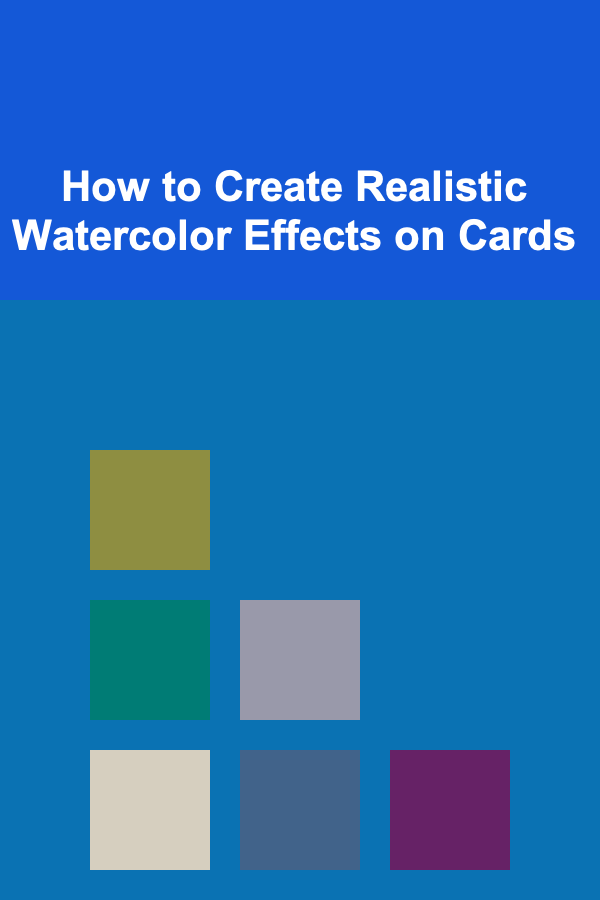
How to Create Realistic Watercolor Effects on Cards
ebook include PDF & Audio bundle (Micro Guide)
$12.99$7.99
Limited Time Offer! Order within the next:

Watercolor painting is a beautiful and versatile medium that allows artists to create stunning, soft, and fluid effects. When it comes to card making, using watercolor techniques can elevate the design, giving your cards a touch of elegance, depth, and sophistication. Whether you're creating greeting cards, invitations, or thank-you notes, learning how to incorporate realistic watercolor effects can help you achieve breathtaking results. This article will explore how to create realistic watercolor effects on cards, providing a step-by-step guide, tips, and techniques to bring your designs to life.
Understanding the Basics of Watercolor
Before diving into techniques, it's essential to understand the nature of watercolors. Watercolor paint is made by suspending pigment in a water-based solution. When applied to paper, the water causes the paint to flow and blend, resulting in soft edges, vibrant hues, and beautiful gradients. The level of control an artist has over watercolor depends on factors like the amount of water used, the type of paper, and the technique employed.
Key tools and materials for watercolor effects on cards:
- Watercolor paint (tube or pan)
- Watercolor brushes (round, flat, or angled)
- Watercolor paper (preferably 100% cotton, cold-pressed)
- Water (clean, to activate the paint)
- Palette or mixing tray
- Masking fluid (optional, for preserving areas of white)
- Paper towels or sponges (for blotting and correcting mistakes)
Step 1: Choose the Right Paper for Watercolor
The first step to achieving realistic watercolor effects on cards is selecting the right paper. Regular cardstock might buckle or warp when exposed to the amount of water required for watercolor painting. Instead, opt for watercolor paper, which is specifically designed to handle moisture without compromising the texture.
When choosing watercolor paper, consider the following factors:
- Weight: Watercolor paper typically comes in 190gsm (lightweight) to 800gsm (heavyweight). The heavier the paper, the more water it can absorb without warping. For card-making, 300gsm cold-pressed watercolor paper is a great choice.
- Texture: Watercolor paper comes in three main textures: cold-pressed (smooth), hot-pressed (rough), and rough. Cold-pressed paper is the most commonly used for realistic watercolor effects as it has a slight texture that helps with blending and creating soft gradients.
Step 2: Set Up Your Workspace
Having a clean and organized workspace is essential for any painting project, especially with watercolor. Watercolors require a lot of space for mixing paints, controlling water levels, and ensuring that the painting surface remains dry.
- Protect your surface: Cover your workspace with a plastic sheet or disposable paper to protect it from water spills.
- Have everything within reach: Place your watercolor paints, brushes, paper towels, and water containers close to your painting area to avoid interruptions during the painting process.
- Use a palette: A ceramic or plastic palette is ideal for mixing colors and diluting the paints to the desired consistency.
Step 3: Plan Your Design
Before jumping into the painting process, it's essential to plan your card design. Think about the composition, color palette, and overall effect you want to create. You can sketch your design lightly with a pencil before applying any watercolor. This helps ensure that the proportions and layout are correct and serves as a guide for painting.
Tips for planning your watercolor card design:
- Consider the focal point: Decide on the main feature of your card, such as a floral arrangement, landscape, or abstract design. This focal point should be painted with the most detail, while the background can be more abstract and soft.
- Choose a harmonious color palette: Select colors that work well together and complement the overall theme. For example, soft blues and greens create a calming, serene effect, while warm oranges and yellows evoke energy and warmth.
- Incorporate negative space: Use the natural white areas of the paper to add contrast and balance to your design. Negative space can highlight certain elements, making them stand out against the soft, blended watercolor background.
Step 4: Master the Wet-on-Wet Technique
One of the most effective ways to create realistic watercolor effects is by using the wet-on-wet technique. This method involves applying wet paint to a wet surface, allowing the pigments to blend and flow into each other. It's ideal for creating soft gradients, atmospheric effects, and blending colors seamlessly.
How to use the wet-on-wet technique:
- Wet the paper: Use a clean brush or spray bottle to apply a light mist of water onto your watercolor paper. Make sure the paper is evenly wet, but not soaking.
- Apply the paint: Using your brush, pick up some watercolor paint and apply it to the wet paper. The paint will flow and spread, creating a soft, blended effect. You can add additional layers of color while the paper is still wet to build up depth.
- Control the flow: Tilt your paper or use a clean brush to move the paint around if you want it to flow in a specific direction. To stop the flow, use a dry brush or let the paper dry.
This technique is perfect for creating dreamy backgrounds, subtle color transitions, and blending different hues seamlessly. It works especially well for backgrounds, sky effects, and flower petals.
Step 5: Add Detail with Wet-on-Dry Technique
While the wet-on-wet technique creates soft, flowing effects, the wet-on-dry technique allows for more control and definition. This technique involves applying wet paint to dry paper, which results in sharper lines and more distinct details.
How to use the wet-on-dry technique:
- Let the paper dry: Allow the background or any larger areas of your card to dry completely before adding details.
- Apply the paint: Using a damp brush, apply watercolor to the dry paper. Since the paper is dry, the paint will remain concentrated and not spread as much, allowing you to create fine details.
- Build layers: If needed, you can apply multiple layers of paint using the wet-on-dry technique to intensify the colors and create shadows or texture.
This technique is ideal for adding fine details, such as the veins of a leaf, the petals of a flower, or intricate patterns on a card design.
Step 6: Create Texture with Salt
For added texture and realism, you can incorporate salt into your watercolor card designs. When sprinkled on wet watercolor, salt creates interesting patterns and textures, ranging from a speckled effect to larger crystalline shapes.
How to use salt for texture:
- Apply watercolor: Paint the area of your card with a wet watercolor wash.
- Sprinkle salt: While the paint is still wet, sprinkle a small amount of salt (regular table salt works best) onto the surface.
- Let it dry: Allow the paint to dry completely. The salt will absorb water and create unique, textured patterns that resemble textures found in nature, like rocks, clouds, or landscapes.
Salt is especially effective for creating natural-looking textures in sky backgrounds, sand, and stone elements.
Step 7: Use Masking Fluid for Fine Details
Masking fluid is a liquid latex that can be applied to areas of your watercolor card that you want to remain white. It is particularly useful when you want to preserve small details, such as highlights or intricate shapes, and prevent them from being painted over.
How to use masking fluid:
- Apply the masking fluid: Using a fine-tipped applicator or a brush, apply masking fluid to the areas of your design you wish to keep white. For example, you might want to preserve the highlights of a flower or the edges of a leaf.
- Allow to dry: Let the masking fluid dry completely before applying watercolor over it.
- Paint over the masking fluid: Once the masking fluid is dry, you can proceed to paint the rest of your design.
- Remove the masking fluid: After your painting is complete and dry, use an eraser or your fingers to gently rub off the masking fluid, revealing the untouched white paper underneath.
Masking fluid is great for adding fine details, such as intricate patterns, small highlights, or light reflections.
Step 8: Create Gradients and Ombre Effects
Gradients and ombre effects are essential techniques for achieving smooth transitions between colors. They work particularly well for backgrounds, skies, and other large areas on your card.
How to create a gradient:
- Wet the paper: Lightly wet the area where you want the gradient effect.
- Apply the first color: Start by applying a light wash of your first color, such as a soft blue, at one edge of the area.
- Blend the second color: While the first color is still wet, add a second color (e.g., a deeper blue or purple) to the opposite edge and use your brush to blend the colors together. You can also use a clean, wet brush to smooth out the transition.
- Adjust and layer: Repeat the process, layering colors and adjusting the gradient until you achieve a seamless blend.
Gradients and ombre effects can add depth and dimension to your cards, making them more visually engaging.
Step 9: Layering for Depth and Dimension
To create a sense of depth and dimension in your watercolor card, use layering techniques. Layering helps to build complexity in your design and allows you to create highlights, shadows, and depth in your artwork.
How to layer watercolors:
- Start light: Begin by applying a light wash of color to your card.
- Let it dry: Allow each layer to dry completely before adding additional layers.
- Add depth: Gradually add darker layers of paint, paying attention to the areas where shadows would naturally fall.
- Blend and adjust: Use a wet brush to soften any hard edges and create smooth transitions between colors.
Layering is ideal for creating depth in floral designs, landscapes, and other realistic elements on your card.
Step 10: Finish with Pen and Ink
Once your watercolor painting is dry, you can enhance the details and add definition with pen and ink. This is especially effective for outlines, fine details, and accents.
How to finish with pen and ink:
- Select a fine-tip pen: Choose a waterproof pen, such as a Micron or Pigma pen, to add intricate details to your design.
- Add details: Outline elements like flowers, leaves, or other objects to make them stand out. You can also add fine lines, patterns, or texture to enhance the design.
- Be mindful of balance: Use pen and ink sparingly to avoid overpowering the delicate watercolor effects.
Finishing with pen and ink adds precision and contrast, making your watercolor elements pop.
Final Thoughts
Creating realistic watercolor effects on cards is a rewarding and creative process. By mastering techniques such as wet-on-wet, wet-on-dry, masking fluid, and texture creation, you can transform simple cards into stunning works of art. With practice, you'll develop your own unique style and learn how to incorporate watercolor into your card-making projects effectively. Whether you're crafting cards for personal occasions or special events, watercolor effects will add a touch of elegance and beauty to your designs. Happy painting!
Reading More From Our Other Websites
- [Home Renovating 101] How to Add a Second Story to Your Home Without a Major Overhaul
- [Ziplining Tip 101] How to Maintain Your Zipline Gear for Year‑Round Use
- [Personal Finance Management 101] How to Lay the Groundwork for Building a Strong Financial Foundation Before Marriage
- [Star Gazing Tip 101] How to Use a Simple Arduino Light Sensor to Measure Sky Darkness Levels Over Time
- [Organization Tip 101] How to Utilize Local Resources for Educational Activities
- [Home Staging 101] How to Use Accessories to Add Charm During Home Staging
- [Home Soundproofing 101] How to Build a DIY Soundproofing Solution for Your Home
- [Home Rental Property 101] How to Manage Your Time as a Busy Landlord
- [Organization Tip 101] How to Create a Simple System for Tracking Home Expenses
- [Trail Running Tip 101] How Weather, Altitude, and Terrain Affect Your Trail Running Hydration Needs

10 Fun and Easy DIY Holiday Decorations and Crafts for All Ages
Read More
Artistic Influence: Crafting Visual Narratives as an Art Director
Read More
How to Incorporate Nature into Your Holiday Decor
Read More
How to Screen Tenants Using Online Tools and Platforms
Read More
How to Use Collaboration Tools for Group Projects
Read More
How To Learn Object-Oriented Programming (OOP) Principles
Read MoreOther Products

10 Fun and Easy DIY Holiday Decorations and Crafts for All Ages
Read More
Artistic Influence: Crafting Visual Narratives as an Art Director
Read More
How to Incorporate Nature into Your Holiday Decor
Read More
How to Screen Tenants Using Online Tools and Platforms
Read More
How to Use Collaboration Tools for Group Projects
Read More